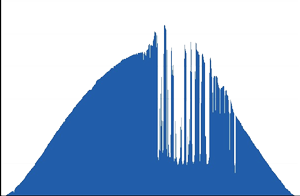Entropic analysis of distributed generation systems
DOI:
https://doi.org/10.3103/S0735272721100046Keywords:
distributed generation system, renewable energy source, solar radiation flux, entropy divergenceAbstract
It is proposed to use the entropy divergence function for entropy analysis of distributed generation systems. A description of the system of distributed generation through the distribution of carriers and resources of generation and consumption is represented. A new method for calculating the probabilities of micro- and macrostates of the system is given. The function of entropy divergence is obtained as an integral characteristic of the macrostate of the distributed generation system, as well as its main properties. The entropic divergence of the solar radiation flux is calculated. The Matlab R2020a Simulink® software environment simulates a distributed generation system consisting of a renewable energy source, a storage device, and an active load. There are represented the time dependences of the storage device charge state modification. The entropy and entropy divergence of the energy flow at the storage device output in such system are calculated. It is shown that to reduce the value of entropy divergence of energy flow at the storage device output, i.e. to bring its operation mode to the maximum allowable, it is necessary in accordance with the entropy divergence of solar radiation flux, taken with the opposite sign, to change the storage capacity without increasing its absolute value. This reduces the duration of the time intervals when the storage device is fully charged and fully discharged, but the energy balance in the system is maintained.
References
- J. Xiao, X. Liu, X. Hu, G. Zhang, J. Shen, “Design of a data system for the avionics system based on the open system architecture,” in 2019 14th IEEE Conference on Industrial Electronics and Applications (ICIEA), 2019, pp. 1958–1962, doi: https://doi.org/10.1109/ICIEA.2019.8834139.
- A. I. Wilson, Entropy in Urban and Regional Modelling. London: Taylor & Francis, 1970.
- H. Zhang, S. He, “Analysis and comparison of permutation entropy, approximate entropy and sample entropy,” in 2018 International Symposium on Computer, Consumer and Control (IS3C), 2018, pp. 209–212, doi: https://doi.org/10.1109/IS3C.2018.00060.
- B. Wu, J. Yi, Q. Yong, “Research on principle and application of maximum entropy,” in 2020 Chinese Control And Decision Conference (CCDC), 2020, pp. 2571–2576, doi: https://doi.org/10.1109/CCDC49329.2020.9164431.
- I. V. Prangishvili, Entropic and Others System Regularities: Questions of Complex Systems Control, [in Russian]. Moscow: Nauka, 2003.
- A. V. Makkuva, Y. Wu, “Equivalence of additive-combinatorial linear inequalities for Shannon entropy and differential entropy,” IEEE Trans. Inf. Theory, vol. 64, no. 5, pp. 3579–3589, 2018, doi: https://doi.org/10.1109/TIT.2018.2815687.
- K. S. Osypenko, V. J. Zhuikov, “The influence of the statistical character of system elements parameters on the level of storage charge,” Tekhnichna Elektrodynamika, vol. 2019, no. 1, pp. 16–20, 2019, doi: https://doi.org/10.15407/techned2019.01.016.
- K. S. Klen, V. Y. Zhuikov, “The influence of stochastic energy character in distributed generationsystems on their stability,” Tekhnichna Elektrodynamika, vol. 2020, no. 3, pp. 62–68, 2020, doi: https://doi.org/10.15407/techned2020.03.062.
- N. I. Delas, “‘Correct entropy’ in the analysis of complex systems: what is the consequence of rejecting the postulate of equal a priori probabilities?,” Eastern-European J. Enterp. Technol., vol. 4, no. 4(76), p. 4, 2015, doi: https://doi.org/10.15587/1729-4061.2015.47332.
- S. P. Bihari et al., “A comprehensive review of microgrid control mechanism and impact assessment for hybrid renewable energy integration,” IEEE Access, vol. 9, pp. 88942–88958, 2021, doi: https://doi.org/10.1109/ACCESS.2021.3090266.
- R. Shady S., O. Ellabban, S. Bayhan, H. Abu-Rub, F. Blaabjerg, M. M. Begovic, “Smart Grid Architecture Overview,” in Smart Grid and Enabling Technologies, Wiley, 2021, pp. 1–43.
- S. Kullback, R. A. Leibler, “On information and sufficiency,” Ann. Math. Stat., vol. 22, no. 1, pp. 79–86, 1951, doi: https://doi.org/10.1214/aoms/1177729694.
- M. Milankovich, Mathematical Climatology and Astronomic Theory of Climate Fluctuations, [in Russian]. Moscow: GONTI, 1939.
[14] N. M. Elsayed, R. A. Swief, S. O. Abdellatif, T. S. Abdel-Salam, “Photovoltaic applications for lighting load energy saving: case studies, educational building,” in 2019 International Conference on Innovative Trends in Computer Engineering (ITCE), 2019, pp. 564–569, doi: https://doi.org/10.1109/ITCE.2019.8646485.
- “LARES – Laboratory for Renewable Energy Systems of University of Zagreb, Faculty of Electrical Engineering and Computing.” https://www.lares.fer.hr/.
- V. P. Diakonov, MATLAB. Full Self-Instruction Book, [in Russian]. Moscow: Press, 2012.


